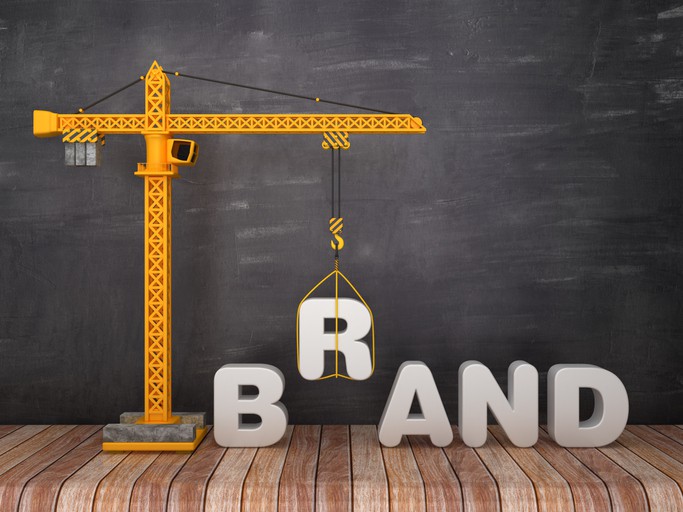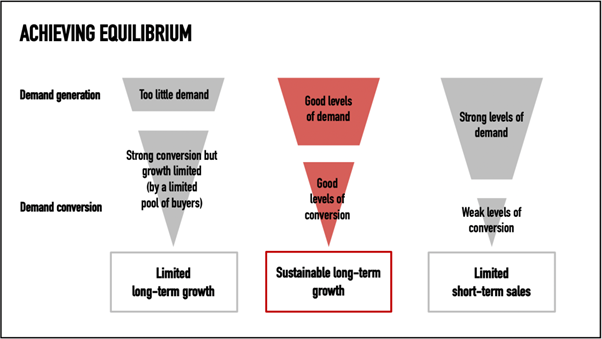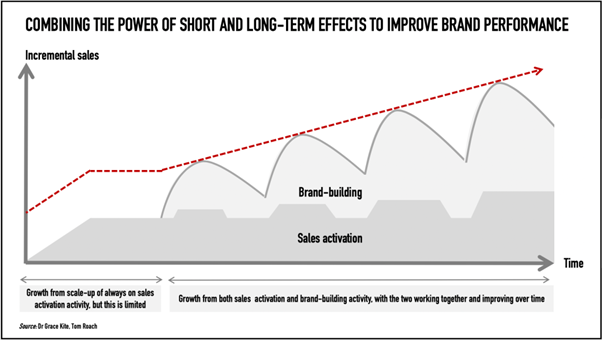
Five years ago, I didn’t believe that brand building worked for SMEs, I thought it was for large companies with massive marketing budgets. Fast-forward to today and I preach about the need for brand building to everyone that will listen.
It’s a big statement, but I would go as far as to say that if you are not growing, it is likely to be because you are not investing in your brand!
There are two simple points that are important to make to back up the need for brand building activity. The first is why would anyone buy from you if they had never heard of you?
The second is the study by LinkedIn and Ehrenberg-bass that found that 95% of all B2B customers are not in the market to buy your product right now, although, of course, they will be at some point in the future, which is where brand building comes in. The role of brand building is to persuade potential customers of your value, so that when they are ready to buy, they come to you.
What is brand building?
Many brands start with bottom of the funnel activity, also known as ‘sales activation’. This is simply trying to push for a sale at the bottom of the sales funnel where there is a need for your product from customers. Over time, this approach isn’t as effective and doesn’t yield the same results – questions get asked around increasing acquisition costs and the same marketing budget begins to yield less results.
When you only invest in ‘sales activation’ or, as most B2B brands know it as, ‘lead generation’, it’s unfortunately a law of diminishing returns. Fighting at the bottom of the funnel leaves you open to more competition, which in turn drives up advertising costs, as competition in areas such as CPC pushes prices up. Worse of all, competitors investing in brand awareness leading to less of a market for lead generation.
Brand building, simply, is top of the funnel marketing that builds awareness of your company. The intent is for your brand to be memorable and top of mind to potential customers. Of course, the marketing funnel is not linear, but brand building is not about attempting to make a sale, it is about looking to create a connection.
The best approach is a balanced approach
If you are looking for the answer as to how to best invest in brand building and create a balanced approach, I’m sorry because you aren’t getting it here.
For those that are still reading, there is some incredible theory out there, created by people much smarter than me, that I will try and summarise below.
The most publicised concept of ‘sales activation’ vs. ‘brand building’ came from a paper called ‘The Long and Short of it’, by Les Binet and Peter Field (It is an incredible book that you should definitely read). This really started the movement around the need for brand building and how companies that invest in brand receive long-term growth. However, at the time that it was published, there was quite a bit of scepticism, especially around the fact that not every company is the same, or has the same industry, the same customer base, even in the same lifecycle stage.
‘The wrong and short of it’ by Tom Roach, takes the theory further and starts to build upon some of the gaps in the Binet and Field approach. Ultimately, there is no golden ratio, but we are introduced to the concepts of ‘short-termism’ and ‘long-termism’.
‘Short-termism’ is related to sales activation, the focus on direct ROI activity that halts growth over the long-term. ‘Long-termism’, you guessed it, is activity focused on brand building. We have focused on how not investing in brand is bad, but the same can be said for those that only invest in brand and not sales activation, mainly due to the lack of direct sales driving activity.
The key is to achieve balance, making both sales activation and brand awareness work together in harmony, finding, as Tom Roach puts it, the equilibrium.

The equilibrium can only be found through first removing our current beliefs in how long-term sales are made. Get rid of the concept that long-term growth is created by throwing money at the bottom of the funnel. Good marketers also know that without sales in the short-term, there may not even be a long-term. We need to harness the effects of combining short and long-term activities, so we create that balance.

The above graph is the key takeaway of this article. Initial performance is coming from sales activation and then that performance starts to plateau. It is at this point that, when brand-building activity is layered on top of sales activation, sales will start to increase over time. Notice how the brand activity also supports the improvement of sales activation activity as well its own long-term sales. The graph also depicts the compound effect of both strategies running in parallel.
Theory is great, but what does this look like in reality?
You need to start by putting aside a fair amount of budget to invest in brand building activity if you truly want long-term growth. There is little point in assigning a small proportion of your overall budget because it will have little effect and be wasted.
The minimum recommendation of budget for brand building is 30% of your overall advertising budget. Ideally, this should be in addition, and not taken away from, sales activation activity. However, if this is not possible and you then see your short-term sales decrease, you need to increase your budget, not take it away from brand building activity. Why? That’s right, brand building is a long-term activity and has to be seen as an investment – and you have to commit to it.
A critical point that isn’t made in the theory presented is that just because you invest in brand building, doesn’t mean it will be effective. The key with brand building activity is that you don’t want to waste budget and wasting budget can happen in two ways: (1) you can spend budget advertising to the wrong people and (2), your brand advertising is not memorable, and you are never top of mind.
By far, the best channel for brand building is LinkedIn due to its targeting methods – so you should always be advertising to the right people if set up and managed correctly. Making sure your advertising is memorable is the most difficult part because it requires strong creative and ideation to make sure that you build a concept that really is memorable (invest in this!). On average, people in the UK see more than 5,000 ads per day. If your ad is not memorable, you will not grow.
If you need any support on your brand building activities, please get in touch with me at: matt.berry@cremarc.com
Want to read more about digital marketing, read our blog post on Account Based Marketing.